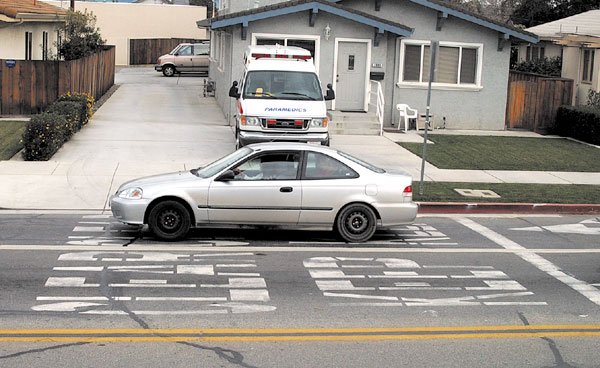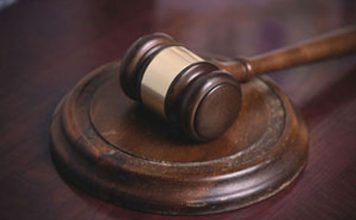Gilroy
– A noisy world of cell phones, talk radio and booming
subwoofers is distracting drivers. Unfortunately for local
emergency responders, those drivers are also too distracted to
notice when a vehicle with lights flashing and sirens blaring is
headed their way.
By Lori Stuenkel
Gilroy – A noisy world of cell phones, talk radio and booming subwoofers is distracting drivers. Unfortunately for local emergency responders, those drivers are also too distracted to notice when a vehicle with lights flashing and sirens blaring is headed their way.
That distraction can lead to unexpected reactions from drivers and ultimately cost emergency workers a few seconds of response time.
“What happens at times is, it catches them by surprise,” said Capt. Colin Martin with the Gilroy Fire Department. “That element of surprise can cause them to maybe freeze or not make the best decisions.”
Drivers generally move to the right, Martin said, when they see police cars, fire trucks or ambulances approaching with lights and sirens – or “Code 3” – as is required by the California Driver Handbook issued by the Department of Motor Vehicles.
Emergency vehicles drive Code 3 when dispatched to a fire or medical emergency, or to a vehicle accident – any situation where lives are threatened.
In those situations, state law requires drivers to drive as close to the right side of the road as possible and stop until the emergency vehicle passes.
“We can get right behind people and have them not even see us,” said Sgt. Kurt Ashley with the Gilroy Police Department.
The same can be true on Highways 101 or 152, which are patrolled by the California Highway Patrol.
“It’s always drilled into our heard that people don’t see you and don’t hear you,” Officer Matt Ramirez said. “Drivers don’t know where to go and people kind of panic. They go to the center divider, which is wrong, or they stop in the middle of the lane, and that’s wrong.”
When distracted drivers in town notice a vehicle in Code 3, they also often stop or react erratically.
GFD Division Chief Phil King said he has seen drivers in the far left lane cross oncoming traffic and pull over to the left side of the street.
Abrupt stops or unexpected movements are likely to cause rear-end collisions either involving an emergency vehicle or the vehicles behind it, he said.
Drivers who occupy “Keep Clear” zones in front of the city’s fire stations and an ambulance location at Church and First streets can cause problems as well. Most of the time, Martin said, drivers in front of the Las Animas station at Wren and Welburn avenues have enough advance warning that they clear the area in time.
“When they see that door come up on the fire station, they’ll definitely move,” he said.
At the ambulance station on Church Street Monday, two paramedics pulled the vehicle into the driveway as they prepared to respond to a call. A few minutes later, they started down the driveway as the light at the nearby intersection turned green. The ambulance lights turned on and the siren blasted as a pick-up left the “Keep Clear” zone and cars behind it yielded to the ambulance.
To keep emergency vehicles moving, Gilroy fire engines are outfitted with a special strobe light that can change upcoming red lights to green from as far as a quarter-mile away, King said. Once the engines are through the intersection, the light cycle returns to normal.
Drivers who try to quickly flash their headlights on and off to get a light to change are out of luck, though, because the strobe lights and sensors require precisely timed intervals.
CHP patrol cars also have the green light triggers, funded by the retail developments and Highways 101 and 152, where their headquarters is located.
That area is one of the trickiest for officers because of a barrier in the road, several intersections in a row and a high number of cars, particularly during commute hours.
A barrier makes maneuvering extremely difficult because emergency vehicles cannot easily pass on the left.
“Look in the rear view mirror and if you can’t move to the right, slow down cautiously and we will try to make the determination of what we can do,” Sgt. Ashley said.
Emergency vehicles driving Code 3 have the right of way, including the right to cross traffic, but must use it responsibly.
“The law is allowing us to go through a place we would otherwise have to stop – at a red light or a stop sign – but when we have lights and sirens, we’re asking permission,” Martin said.
Emergency responders approaching an intersection will slow down to see what other drivers are doing, making eye contact if possible, he said.
At intersections where drivers are stopped, emergency vehicles might slowly drive into lanes of oncoming traffic, if they’re clear.
In other instances, if drivers are unwilling or unable to move to the right, officers might pass them on the right, in which case they will momentarily turn the lights and sirens off to avoid any confusion, Ashley said.














